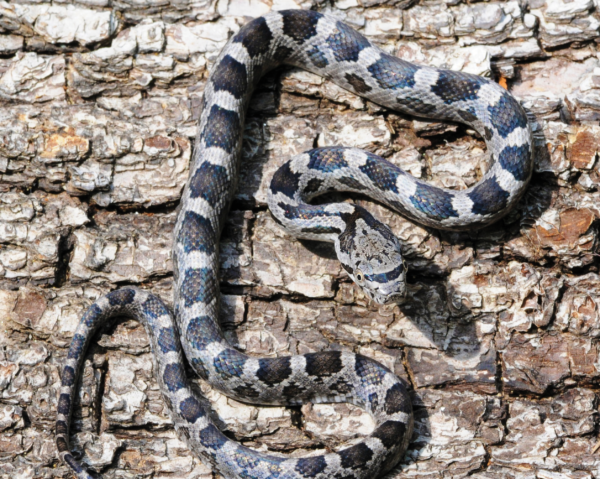
Eastern Ratsnake. Photo credit and copyright: John White.
It’s a good time to talk about SSSSNAKES! It’s a good time to talk about a lot of things, really—frogs, migrating birds, wildflowers, bats, turtles, and much more—but snakes are a particularly hot topic now and in the coming months. Every year around early- to mid-spring, we receive phone calls, emails, and the occasional visitor with questions about, photos of, specimens of snakes. This is the time of year these animals begin to venture out of their hibernacula in search of food, mates, and shelter.
Snakes are overwhelmingly misunderstood and given undeserved bad reputations. They are just built very different from us and many other animals. Meanwhile, they are extremely important to have around to control various pests. Many of our larger snakes eat mice, rats, moles, voles, and other small mammal pests. Smaller snakes eat plenty of bugs, slugs, and other very small pests.
We’re often asked if the snake in question is a “good” snake. The proper response is that all snakes are “good” snakes! Snakes, even venomous snakes, will not bite a person unless it were a very last resort. You have to touch them in some way to get them to bite. Always take common sense precautions to avoid accidentally touching snakes, too.

Common Rainbow Snake. Photo credit and copyright: John White.
If you’re outside doing yard work, hiking, or the like, never put your hands or feet where you cannot see. It’s always a good idea to use long-handled tools if you are moving things like landscape timbers, rocks, or piles of mulch, just in case a snake or other wildlife may be hiding under it. When hiking, it’s always good to have a walking stick or similar implement to poke around any tall grass or rocks you are about to venture through to make sure there are no snakes or other wildlife hiding.
Also, rest assured that snakes do not chase people—this is an absolute myth. A snake has no reason to chase you, since you are much too big to be prey for a snake. You are only considered a predator to a snake. There are times when their behavior is misunderstood: when a snake is trying to get to where it knows to hide, you may be inadvertently standing between the snake and that place. Snakes usually do not see as well as people, too, so it may be heading towards you without realizing it. Simply move out of its way, and there will be no problem.
Another misunderstood behavior is snakes being close to people in order to get food from people. Northern watersnakes, which are nonvenomous and common around any type of water throughout Virginia, have been known to learn to find “fast food” when hanging around anglers at popular fishing holes. Watersnakes love to eat fish, and they may hang around an angler’s fishing line hoping to snag a fish that’s caught!
If you are experiencing a problem with snakes or other wildlife, please dial our toll-free wildlife conflict helpline at 1-855-571-9003.
You can also purchase A Guide to the Snakes and Lizards of Virginia, an informative publication available ShopDWR.com.
Here are a couple of useful links with information on, and photos of, snakes in Virginia:


